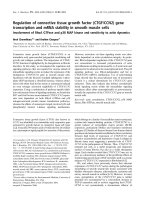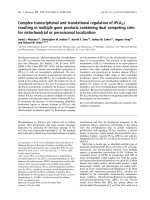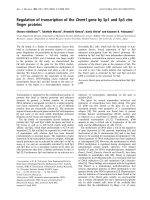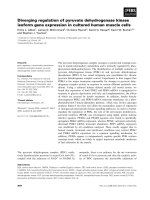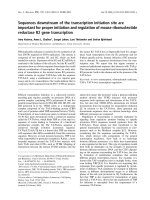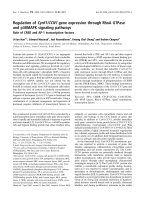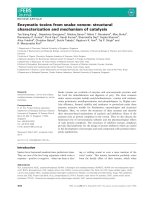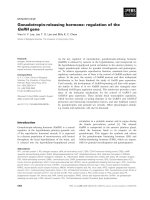Gene regulation of snake venom prothrombin activators
Bạn đang xem bản rút gọn của tài liệu. Xem và tải ngay bản đầy đủ của tài liệu tại đây (629.95 KB, 175 trang )
GENE REGULATION OF
SNAKE VENOM PROTHROMBIN
ACTIVATORS
KWONG SHIYANG
B.SC. (HONS.), NUS
A THESIS SUBMITTED FOR THE DEGREE
OF DOCTOR OF PHILOSOPHY
DEPARTMENT OF BIOLOGICAL SCIENCES,
NATIONAL UNIVERSITY OF SINGAPORE
2010
i
ACKNOWLEDGEMENTS
The writing of this section is a time which all PhD students look forward
to. This time of reflection causes me to recall all the individuals who have guided
and encouraged me along the way. Without their support, this journey would be
more difficult. Hence, I would like to take this opportunity to express my heartfelt
gratitude to these people.
I would like to thank my supervisor, Professor R. Manjunatha Kini for his
guidance and support. Without his acceptance into the Protein Science Laboratory,
this thesis would not have materialized. Prof Kini has always been an open
channel of communication which is a luxury for any graduate student. His door is
always open and he would be behind the desk ready for discussion. He has not
only taught me to do high quality research, but more importantly, guided me to
think critically and independently as an individual. I am also fortunate to have
Associate Professor Ge Ruowen as my co-supervisor. Her guidance and input has
been invaluable towards this PhD thesis. I would like to thank the graduate
programme run by the National University of Singapore for their financial support.
I was privileged to perform part of my research in Adelaide, Australia. I
would like to thank Professor Anthony Woods of the University of South
Australia for accepting me into his laboratory during that time. I would also like
to thank Mr Peter Mirtschin of Venom Supplies Pty Ltd. for providing the snakes
ii
to be sacrificed for their venom glands. The one month period in Australia was
definitely a memorable experience for me.
The Protein Science Laboratory is like a big extended family. I have made
many friends and it has certainly enriched my experience. Firstly, I would like to
thank my senior, Reza, who was my mentor when I was doing my honors project.
Reza imparted many molecular biology techniques which he had painstakingly
learnt by himself. I would like to thank our previous postdoctoral fellow, Robin,
and my senior, Cho Yeow, for sharing their experiences with me. Research is
stressful and it is great to have friends whom you can joke around with. I would
like to give special mention to my lunch and coffee buddies: Amrita, Girish,
Angelina and Chun Shin. I also thank Ryan, Shifali, Bhaskar, Angie, Sindhuja
and Nazir for their support and making the lab nice to place to work in. Besides
my lab members, special mention has to be given to Bee Ling. She has been a
great source of support as our lab officer in the lab.
I am very blessed to have my family who has been there to support me.
My wife, Delphene, and our firstborn, Samuel, has been a constant source of
inspiration and motivation. They have been my harbor where I seek refuge when I
feel like giving up. I would have definitely not made it without them. I also want
to thank my parents who had always supported and encouraged me to do a PhD. I
thank them for their nurturance, love and for bringing me up to be the man that I
am today. Also, I like to thank them for helping to look after Samuel so that I can
iii
concentrate on writing this thesis. Most importantly, I thank God for always
providing and blessing me along this long PhD journey.
Kwong Shiyang
August, 2010
iv
TABLE OF CONTENTS
Page
Acknowledgements i
Table of Contents iv
Summary vi
List of Figures ix
List of Tables xi
Abbreviations xii
Chapter One Introduction 1
A brief introduction to gene duplication,
the recruitment of snake venom toxins
from body proteins, and transcription;
overview of prothrombin activators from
snake venom; Aims and Scope
Chapter Two Characterization of trocarin D VERSE promoter 50
The role of VERSE promoter in trocarin D
expression; characterization of VERSE for
its regulatory cis-elements in primary
Pseudonaja textilis snake venom gland
cells and mammalian cell lines
Chapter Three Identification of silencer cis-element within 78
trocarin D intron 1 insertion/deletion segments
Characterization and confirmation of
trocarin D intron 1 insertions/deletions
using mammalian cell lines
Chapter Four Identification of trans-factors that interact with 106
novel VERSE cis-elements
Purification and identification of the
transcription factors from nuclear extracts
which interact with the novel VERSE
cis-elements
v
Chapter Five Conclusions and future prospects 134
Conclusion, limitations, implications
and future prospects
Bibliography 148
Appendices 161
List of publications, patents and conferences
achieved during the course of this thesis
List of primers used for making VERSE constructs
vi
SUMMARY
Snake venom prothrombin activators are functional and structural
homologues of blood coagulation factors. It is hypothesized that the venom
prothrombin activators evolved from blood coagulation factors by gene
duplication. The copy gene of the blood coagulation factor is genetically modified
which causes changes to its expression pattern. The modified copy gene becomes
differentially expressed than its ancestral gene to become a toxin gene, i.e. it
expression becomes elevated and exclusive in the venom gland. This whole
process is broadly termed as “venom recruitment”.
Trocarin D, a group D venom prothrombin activator, resembles activated
mammalian blood coagulation factor X (FXa). Both trocarin D and FXa activate
prothrombin to thrombin by targeting the same cleavage sites and have identical
domain architectures. Despite such similarities, trocarin D and FXa have different
expression patterns which facilitate their respective functions. While FX functions
as a haemostatic factor and has low level of liver-specific expression, trocarin D
functions as a toxin and has high level of venom gland-specific expression. A
snake FX-like (TrFX) cDNA sequence was determined from the liver of
Tropidechis carinatus. Comparison of trocarin D and TrFX gene organizations
confirmed that trocarin D was “recruited” from TrFX. Both genes have identical
architectures and significant sequence identities, except for insertions/deletions in
their promoter and intron 1 regions. Compared to TrFX, the trocarin D promoter
has a 264 bp insertion termed as the Venom Recruitment/Switch Element
vii
(VERSE). Compared to TrFX, the trocarin D intron 1 has three insertions and two
deletions. These insertions/deletions in the promoter and intron 1 regions are
hypothesized to facilitate the “venom recruitment” process of TrFX into the
venom gland transcriptome for elevated and specific expression as a toxin.
However, more importantly, these insertions/deletions are hypothesized to
regulate the expression of trocarin D. Using trocarin D as a representative, this
thesis aims to characterize the promoter and intron 1 insertion/deletion segments
to investigate the gene regulation of snake venom prothrombin activators.
The trocarin D VERSE promoter segment was characterized using
luciferase assays in primary snake venom gland cells and mammalian cell lines.
VERSE is capable of driving luciferase expression and its up-regulatory effect is
comparable to the full trocarin D promoter. Hence, this indicates that VERSE is
the main segment responsible for the trocarin D elevated expression in the venom
gland. Subsequent characterization confirms the presence of TATA-, GATA- and
Y-box cis-elements. Three other novel cis-elements (Sup, Up1 and Up2) were
also identified and characterized. The transcription factor which interacts with the
Sup cis-element was purified and identified as a class 6 POU transcription factor.
Although expression of trocarin D is venom gland-specific, VERSE is still able to
drive luciferase expression in mammalian cell lines. Hence, the trocarin D intron
1 insertion/deletion segments were characterized for their roles in tissue-specific
expression.
viii
The insertion/deletion segments within the trocarin D intron 1 region were
characterized using luciferase assays in mammalian cell lines. A scaffold matrix
attachment region which was previously predicted using bioinformatics tools was
found to be nonfunctional. The characterization of the trocarin D intron 1
insertion 2 segment pinpoints a 26 bp segment as a silencer cis-element which
probably functions to “turn off” trocarin D expression in other tissues. The results
of this thesis have elucidated how trocarin D is regulated for its elevated and
tissue-specific expression. Finally, it has significantly contributed towards our
understanding of gene regulation of snake venom prothrombin activators.
ix
LIST OF FIGURES
Chapter One
Figure 1.1: Domain architecture of mammalian FXa, trocarin D and pseutarin
C catalytic subunit (PCCS).
Figure 1.2: Domain architecture of mammalian FV and pseutarin C
nonenzymatic subunit (PCNS).
Figure 1.3: Phylogenetic tree of snake venom prothrombin activators and
blood coagulation factors.
Figure 1.4: A. Cis-elements of human, murine, TrFX, trocarin D and PCCS
promoter regions B. Comparison of TrFX and trocarin D intron
one regions.
Chapter Two
Figure 2.1: Comparison of TrFX, trocarin D and VERSE promoter activities in
mammalian cell lines.
Figure 2.2: Characterization of predicted VERSE cis-elements and comparison
of VERSE promoter activity between primary P. textilis venom
gland cells and mammalian cell lines.
Figure 2.3: Influence of TLB3 and TLB2 on transcription start sites.
Figure 2.4: Characterization of VERSE promoter by serial deletions and
identification of minimal core promoter.
Figure 2.5: Characterization of novel cis-elements constructs.
Figure 2.6: Comparison of VERSE and CMV promoter activity.
Figure 2.7: Complete characterization of the VERSE promoter.
x
Chapter Three
Figure 3.1: (A) The intron/exon boundaries of the 5’ and 3’ end of the trocarin
D intron 1. (B) The amplified trocarin D intron 1 insertion/deletion
segment with the five nucleotides straddling the intron/exon
boundaries of intron 1 to preserve intron splicing during mRNA
maturation.
Figure 3.2: Characterizing the gene regulatory role of intron 1
insertion/deletion segments.
Figure 3.3: Identification of the silencer cis-element within Ins2.
Figure 3.4: Identification of the silencer cis-element within Ins2.2.
Figure 3.5: Identification of the silencer cis-element within Ins2.
Figure 3.6: Alignment of the identified BLASTN matches regions to Ins2.2.4.
Figure 3.7: Alignment of trocarin D and PCCS intron 1 insertion 2 segment,
and trocarin D silencer cis-element.
Chapter Four
Figure 4.1: EMSA of 5’ biotin labeled oligos which correspond to the three
novel VERSE cis-elements (Sup, Up1 and Up2).
Figure 4.2: Silver staining of the DNA-affinity chromatography purified
trans-factors that bind to the Sup oligo.
Figure 4.3: Silver staining of the DNA-affinity chromatography purified
trans-factors that bind to the Up1 and Up2 oligo.
Figure 4.4: A. Peptide mass fingerprinting (PMF) of the 37 kDa protein from
the Sup DNA-affinity chromatography profile. A. Sequence
coverage of the polypeptides against POU class 6 homeobox 1
(gi|223890225). C. The spectrum of the PMF.
Figure 4.5: A. Peptide mass fingerprinting (PMF) of the 35 kDa protein from
the Sup DNA-affinity chromatography profile. A. Sequence
coverage of the polypeptides against POU class 6 homeobox 1
(gi|223890225). C. The spectrum of the PMF.
xi
LIST OF TABLES
Chapter One
Table 1.1: Classification of snake venom prothrombin activators.
Table 1.2: Comparison of the venom and plasma prothrombin activators.
Chapter Three
Table 3.1: BLASTN analysis of Ins2.2.4 against NCBI database. Only 100%
matches are listed.
Table 3.2: BLASTN analysis of Ins2.2.4 against snake taxonomy (taxid:
8570) database. Only 100% and shortlisted matches are listed.
xii
ABBREVIATIONS
APC activated protein C
A adenosine
FX blood coagulation factor X
FV blood coagulation factor X
Brn-5 brain-5 protein
cDNA complementary deoxyribonucleic acid
DNA deoxyribonucleic acid
EMSA electrophoretic mobility shift assay
MS mass spectrometry
MALDI/TOF-TOF matrix-assisted laser desorption/ionization time of
flight/time of flight
mRNA messenger ribonucleic acid
PMF peptide mass fingerprinting
POU6F POU family, class 6, transcription factor
POU6F POU Proteins, Class 6, Transcription Factor
POU
H
POU-homeobox
POU
S
POU-specific
PFV Pseudonaja textilis blood coagulation factor V
PFX Pseudonaja textilis blood coagulation factor X
PCCS pseutarin C catalytic subunit
PCNS pseutarin C nonenzymatic subunit
RT-PCR real-time polymerase chain reaction
RP-HPLC reverse-phase high performance liquid
chromatography
RNA ribonucleic acid
3FTX three-finger toxin
TSS transcription start site
TrFX Tropidechis carinatus blood coagulation factor X
VERSE Venom Recruitment/Switch Element
Chapter I - Introduction
1
C
C
h
h
a
a
p
p
t
t
e
e
r
r
1
1
I
I
n
n
t
t
r
r
o
o
d
d
u
u
c
c
t
t
i
i
o
o
n
n
Chapter I - Introduction
2
Our laboratory has extensively characterized trocarin D, a group D snake
venom prothrombin activator, from the venom of Tropidechis carinatus. It is
found to be functionally and structurally similar to activated mammalian factor X
(FXa). A snake FX-like (TrFX) cDNA sequence was determined from the liver of
Tropidechis carinatus. Trocarin D and TrFX share a high degree of similarity but
are different enough to indicate that they are encoded by two different genes.
Real-time polymerase chain reactions confirm that differences in expression
patterns. Trocarin D is expressed exclusively in the venom gland at high levels
compared to TrFX which is expressed mainly in the liver at lower levels. Their
gene organizations were determined to investigate the genetic causes which result
in this difference in expression patterns. Regions of differences were identified
between the trocarin D and TrFX gene which are hypothesized to be responsible
for the differences in gene regulation. These previous results suggest that trocarin
D has evolved from TrFX by gene duplication. The TrFX copy gene underwent
genetic modifications to gain venom toxin expression patterns which facilitated its
differential expression in the venom gland. This whole process is broadly termed
as “venom recruitment”. These genetic differences highlighted between trocarin D
and TrFX give us an opportunity to characterize them for their regulatory
properties, and therefore, understand the gene regulation of snake venom
prothrombin activators.
This recruitment of trocarin D from TrFX is one of the many instances
which snake venom toxins have evolved from ancestral body proteins by gene
Chapter I - Introduction
3
duplication. Before going into the details of this thesis, this chapter will introduce
the phenomenon of gene duplication and the characteristics of ancestral body
proteins which are favored for “venom recruitment”. During this “recruitment”
process, changes occur within the regulatory regions of the duplicated gene which
influences its transcription regulation, and hence, alter its expression patterns.
Therefore, this chapter will also briefly describe the process of transcription and
its regulation. As this thesis focuses on investigating the “recruitment” of snake
venom prothrombin activators from blood coagulation factor proteins, this chapter
will also discuss the work that our laboratory has previously done to establish the
evolutionary relationship between these two groups of proteins. Finally, this
chapter will discuss the factors that motivate the aims and scope of this thesis.
Chapter I - Introduction
4
GENE DUPLICATION
One of the earliest observations of gene duplication was the doubling of a
chromosomal band in a mutant fruit fly Drosophila melanogaster which resulted
in a reduction in eye size (Bridges 1936). As more genomes get sequenced and
annotated, the phenomenon of gene duplication is becoming more evident during
the evolution and development of genomes. The most obvious contribution of
gene duplication is the production of new genetic material for evolution to modify
and generate new genes with new functions. This allows an organism to
constantly adapt and survive when changes occur in its environment. The human
genome has about 40 000 genes, out of which approximately 38% of them are
duplicated genes (Li et al. 2001b). For example, one of the largest multigene
families in the human genome which has arisen due to gene duplication are the
functional olfactory receptor (OR) genes (Niimura and Nei 2003).
Generation of Duplicated Genes
There are three scenarios in which gene duplication can occur, namely (1)
unequal crossing over, (2) retroposition and (3) chromosomal duplication. In the
event of unequal crossing over, the duplicated and original regions are often
located in tandem, i.e. both duplicated and original genes are linked together on
the same chromosome. Depending on the position of the crossing over, the
duplicated region can be part of a gene, an entire gene or even multiple genes.
The duplicated region will have the same gene structures as that of the original
region, i.e. promoter, exon and intron regions. In the event of retroposition, a
Chapter I - Introduction
5
messenger RNA (mRNA) is retrotranscribed into a complementary DNA (cDNA)
and randomly inserted into the genome. Hence, unlike that of the unequal crossing
over, the position of duplicated region is often unlinked with the original gene.
Also, as the inserted segment is a complementary mRNA strand, the duplicated
region usually has no gene structure, i.e. there are no promoter and intron regions,
and might have a poly T region. In the event of a chromosomal duplication, gene
duplication occurs probably due to a lack of disjunction among daughter
chromosomes after DNA replication. However, this often occurs in the plant
genomes and seldom in the animal genome (LI Wen-Hsiung 1997).
Fate of the Duplicated Gene
The birth-and-death model of evolution assumes that new genes are
constantly being created by gene duplication, and while some of the duplication
genes get incorporated and maintained in the genome, the rest of them end up
being deleted due to a strong purifying selection pressure (Nei et al. 1997; Nei et
al. 2000). For those duplicated genes that are maintained in the genome, they end
up either (1) being a pseudogene (pseudogenization), (2) conserving the parental
function, (3) retaining part of the parental function (subfunctionalization) or (4)
gaining a novel function (neofunctionalization).
Pseudogenization
When a gene is duplicated by retrotransposition, there is a loss of
regulatory elements in the duplicated gene, i.e. no promoter and intron regions.
Chapter I - Introduction
6
Therefore, transcription cannot be initiated and the duplicated gene ends up being
a pseudogene. However, in certain situations, the insertion can occur downstream
a promoter region. In this case, the duplicated gene could end up being
transcribed and expressed (Long 2001). Pseudogenization can also occur when
the duplicated gene is initially fixed in the genome but later becomes
nonfunctional or unexpressed due to mutations, which affect its function or
structure.
Pseudogenes can be found in approximately half of all mammalian protein
families with the greatest representation found in housekeeping and ribosomal
families of genes (Zhang and Gerstein 2004). A good example of this process can
be observed in the human olfactory receptor gene family which more than 60% of
the genes are pseudogenes (Rouquier et al. 2000). This could be an outcome of a
relaxation in the olfactory receptor functional constraint. This relaxation could be
due to the development of other sensory mechanisms, such as better vision, which
compensate for a less developed olfactory system.
Conservation of Gene Function
Occasionally, it is beneficial for the organism to have duplicated
functional copies of a gene as it allows more amounts of the protein or RNA to be
produced. In this case, strong selection pressure prevents mutations from
modifying the gene function of the duplicated gene. Translational RNAs such as
tRNA, rRNA, and histones are usually encoded by multiple gene copies that have
Chapter I - Introduction
7
arisen by gene duplication (Duret 2000; LI Wen-Hsiung 1997; Stevenson and
Schmidt 2004; Tsunemoto and Matsuo 2001). There are four histone genes (H1,
H2A, H2B and H4) present in Drosophila simulans which form a gene cluster
(Tsunemoto and Matsuo 2001). Evidence of gene duplication lie in the similarity
of the gene sequences which only differ by 6.3%.
Subfunctionalization
Unless it is beneficial for extra copies of the gene to be present (as
discussed above), it is unlikely for a genome to stably maintain two genes with
identical functions as it would be redundant and costly (Nowak et al. 1997).
Therefore, in the event of subfunctionalization, to ensure that both genes are kept
under selective pressure and are able to be fixed into the genome, there is a
partitioning of the parent gene function. The duplicated gene usually adopts an
aspect of the parent gene function (Hughes 1994), and/or alter their expression
patterns (Gu et al. 2002), i.e. if the ancestral gene is expressed in tissues A and B,
modifications in the cis-regulatory regions would result in one duplicate gene to
be expressed in tissue A and the other to be expressed in tissue B.
An example of subfunctionalization, whereby there is a change in
expression patterns, is snake venom prothrombin activator, trocarin D, and its
blood coagulation factor X (FX) counterpart (Reza et al. 2005a). Both of these
genes promote blood coagulation by activating prothrombin. However, trocarin D
is expressed only in the venom glands while the FX counterpart is expressed in
Chapter I - Introduction
8
the liver. An example of subfunctionalization, whereby the duplicated gene
specializes in an aspect of the parent gene functions, can be observed in the
duplicated pancreatic ribonuclease gene of the leaf-eating monkey Pygathrix
nemaeus. Compared to the parent gene, the duplicated gene has evolved to have
an enhanced ribonucleolytic activity while losing the ability to degrade double-
stranded RNA (Yu et al. 2010).
Neofunctionalization
The most important outcome of gene duplication is the creation of new
novel gene functions. During neofunctionalization, the duplicated gene which is
free from selection pressure gains mutations which alter its gene function. The
duplicated gene evolves either a new function, or in most cases, one which is
related to that of its parent.
An example of neofunctionalization can be seen in the three-finger toxin
(3FTX) multigene family. The members of this family have evolved by gene
duplication and their structure-function relationships have been well-characterized
(Kini 2002). Structurally, all the members of this family share a common structure
of three beta-stranded loops extending from a central core. Despite the structural
similarities, the members are functionally very diverse. Their functions range
from being a neurotoxin, cardiotoxin, acetylcholinesterase inhibitor and many
others (Kini 2002). This diversification is due to molecular mutations within the
functional sites which often result in new ligand-binding specificities (Kini 2002).
Chapter I - Introduction
9
RECRUITMENT OF SNAKE VENOM TOXINS FROM BODY PROTEINS
Snake venom is a complex mixture of biologically active molecules which
perform a variety of functions which ranges from immobilizing, paralyzing,
killing and digesting their prey organisms. Interestingly, many of these toxin
proteins have been observed to be structurally and functionally related to body
proteins (Fry 2005). Hence, it is hypothesized that venom proteins originate from
body proteins whose genes have been “recruited” into the venom gland
transcriptome by gene duplication. One of the first observations of “venom
recruitment” by gene duplication was that 3FTX venom proteins had evolved and
diversified from a single ribonuclease ancestor (Strydom 1973). This
“recruitment” process has not only been observed in snakes but also in venoms of
various others animals, such as cone snails, scorpions and sea anemones.
However, this thesis will use snake venom toxins as a focal point to illustrate how
body proteins have been recruited into the venom arsenal.
Characteristics of Body Proteins that are Recruited for Venom Arsenal
From the characteristics of the venom toxin proteins and their related body
proteins, general properties which make a body protein favorable for
“recruitment” into the venom toxin arsenal can be characterized.
Structural Characteristics
The presence of an N-terminal signal peptide and a large proportion of
cysteine residues are two structural characteristics that favors a body protein for
Chapter I - Introduction
10
recruitment. Snake venom proteins are secreted out of the venom gland upon
expression. Therefore, the presence of an N-terminal signal peptide in the
ancestral body protein would be favorable. However, a non-secretory body
protein could also be recruited but it will need to undergo the incorporation of a
signal peptide by either exon shuffling or interlocus gene conversion and
retrotransposition (Patthy 2003).
Mutations are one of the main driving forces for functional diversification
in snake venom toxins. Therefore, it is important for the venom toxins to be
structurally stable so that they can retain mutations without resulting in any fatal
structural changes. Cysteine residues form disulfide bonds which confer structural
stability. Hence, body proteins with large proportion of cysteine residues are
favorable for recruitment.
Functional Characteristics
As snakes feed on a wide range of organisms, it would be advantageous
for their venom to be functional in all of their preys. Therefore, body proteins
which either target substrates which are universally present or have bioactivities
that are widely conserved across the Kingdom Animalia are favorable for
recruitment into the venom gland transcriptome. An example of a universally
present substrate is hyaluronic acid which is throughout connective, epithelial,
and neural tissues. Hyaluronidase hydrolyzes this substrate at the 1-4 linkages
between N-acetyl-β-D-glucosamine and D-glucuronate residues. Hyaluronidase
Chapter I - Introduction
11
can be found in the venom of Agkistrodon acutus (Xu et al. 1982). Upon
envenomation, this venom toxin causes the degradation of the tissues which leads
to an increase in tissue permeability, and hence, enhances efficient spreading of
the venom.
If a venom protein resembles a body protein whose bioactivity is widely
conserved, the venom protein can attack the prey’s system by functioning as an
exogenous substitute for the endogenous protein. The venom protein then elicits
its toxic effect by causing a physiological imbalance or disrupting a physiological
response. In the case of a physiological imbalance, the concentration of venom
protein together with the endogenous protein will resemble an overexpression of
the endogenous protein. As a body system is tightly controlled by regulating the
concentration of the involved proteins, a sudden unwanted increase in protein
concentration will result in undesired responses or even be fatal. One example is
the AVIT venom toxin whose ancestral protein is the prokinectin protein (Fry
2005). Upon envenomation, the AVIT toxins act as potent agonists of mammalian
prokineticin receptors, and their binding mimics the effect of an endogenous
prokineticin overdose. AVIT toxins have been shown to cause in vitro intestinal
cramping and in vivo increased sensitivity to pain (Li et al. 2001a; Mollay et al.
1999; Schweitz et al. 1999). In the case of a disruption in physiological response,
the venom protein targets the same receptors as the endogenous protein. Hence,
the venom protein functions as a competitive inhibitor to prevent the endogenous
protein from binding to its receptor. One example of a venom inhibitor is
Chapter I - Introduction
12
erabutoxin b, an α-neurotoxin which belongs to the 3FTX family from Laticauda
semifasciata (Sato and Tamiya 1971). This neurotoxin causes paralysis by
competing against and preventing endogenous neurotransmitters such as
acetylcholine from binding to the nicotinic acetylcholine receptor.
Body Proteins to Venom Toxins: Changes in Expression Pattern
For a body protein to be recruited into the venom gland transcriptome, one
of the major modifications it must undergo is changes in expression pattern, i.e.
expression levels and tissue-specific expression. Unlike the expression pattern of
the body proteins which is usually constitutive and low, the expression of the
venom toxins are inducible and high. The expression of the venom toxins has to
be inducible as the toxins need to be expressed only when the glands are empty
and stopped when the glands are full. Also, as the venom is usually an important
component of the snake’s defense and offense, the venom toxins need to be
replenished quickly when the venom gland is emptied (Paine et al. 1992;
Rotenberg et al. 1971). The venom toxins have elevated levels of expression so
that the toxins would be present in sufficient concentrations within the venom to
bring about their toxic effects. Besides these, as the venom toxins could be
potentially toxic to the snake itself, one of the preventive measures is for the
venom toxins to be exclusively expressed in the venom glands. For these changes
of expression pattern to occur, there must be modifications to the regulatory cis-
elements of the gene.

